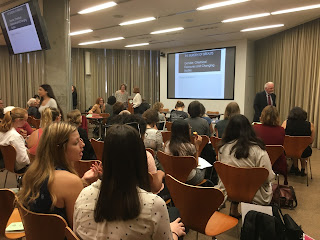Week 9: Space + Art
 |
| Different Perspectives based on Power of Ten |
From our present position in space
and looking at different perspectives based on power of ten, we can reach the
outskirts of the galaxy when we expand our perspectives. Similarly, we can
analyze human bodies by decreasing the power of ten, in which researchers study
organisms on a molecular level. Using the power of ten, a mathematical principle,
we can view lives from very different perspectives. Power of ten gives us a
better understanding of the “intense interaction” human beings live through (EamesOffice).
Increasing on the power of ten
scale, we view life from space. Copernicus McCulloch Kaepernick came up with a
descriptive model of the solar system, where he believed the sun was in the
middle of the solar system (Space Pt1). Kaepernick supported his ideas through
mathematical calculations to describe Earth’s revolution about the Sun and the
tilt of Earth’s rotational axis (Space Pt1). This made people curious about
space and artists began creating science fiction based on their imagination of the
universe.
 |
| Sputnik |
Science fiction became popular and
led scientists to explore space. Sputnik was the first satellite to be put into
orbit around the Earth (Space Pt2). Sputnik was not only meant for scientific
purposes in space exploration, but is also an artwork. It was a shiny steel
sphere with four antennas trailing behind it that would reflect light so that
it could be seen and heard by the human population (Space Pt2). As an art
piece, Sputnik was an important space art because it could be showcased and influence
other countries to quickly develop their own space craft to send to space. This
was important since other countries wanted to demonstrate they have power
through these scientific inventions.
Space art also allows the public
to explore and understand space. It is said that “what distinguishes artist
from viewer appears to be the degree of immersion” (Coded). The public
can experience and walk through space when they look at space art and
understand artists and scientists’ ideas and experiences. Since astronomy is
difficult to comprehend without visualization, space art demonstrates how the
solar system works, what the universe contains, and more. As Annick Bureaud states, “it is
artists and their work that reveal to me the essence of space for human beings
in the twentieth century, as well as my place in the cosmos… they make
me dream and move me deeply” (Leonardo).
 |
| Space Art |
References
"CODED UTOPIA." Continental Drift. N.p., 18 May
2009. Web. 02 June 2017.
EamesOffice. "Powers of Ten™ (1977)." YouTube. YouTube, 26 Aug.
2010. Web. 02 June 2017.
Uconlineprogram.
"8 Space Pt1 1280x720." YouTube. YouTube, 29 July 2013. Web. 02 June 2017.
Uconlineprogram.
"8 Space Pt2 1280x720." YouTube. YouTube, 29 July 2013. Web. 02 June 2017.
"The
Leonardo Space Art Project Working Group." Leonardo Space Art Project
Visioneers. MIT Press, 1996. Web. 02 June 2017.
Images
Michael, Sage.
"Sputnik." Beyond Geek. N.p., 08 Apr. 2015. Web. 04 June 2017.
Nagy, Attila.
"27 Paintings From the Most Famous Space Artist On Earth (And Off)."Gizmodo. Gizmodo.com, 24 Nov. 2014. Web. 04 June 2017.
"Powers of
Ten." Bill Whittle. N.p., 02 Nov. 2013. Web. 04 June 2017.


This is such a thought out and well-organized post. It synthesized and presented this week's topics in a logical manner. Beginning with the perspective given by the Powers of Ten video, to Kaepernick's heliocentric model and artists influenced by him, to the fascination with space and its pervasion of popular culture, your post concludes with the relation between art and space science. You helped me comprehend Space + Art more than I did before. I especially appreciate the final quote you have included by Annick Bureaud as it encapsulates what I attempted to explain in my own post on the role of artists in our understanding of space
ReplyDeleteVery organized and concise post. if you're interested in looking at immersive space art, I'd recommend VR. A lot of VR sets come with a default 'space' setting which is really cool and kind of disconcerting. I liked your diving into and description of the Powers of Ten, and you perfectly described what was covered in parts of the lecture.
ReplyDelete